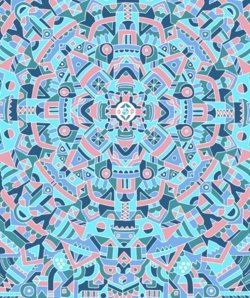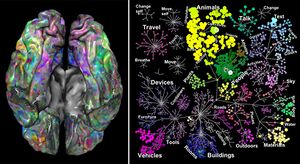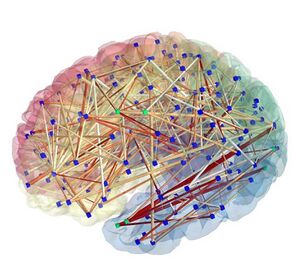Geometry

Geometry can be described as the experience of a person’s field of vision being partially or completely encompassed by fast-moving, kaleidoscopic and indescribably complex geometric patterns, form constants, phosphenes, shapes, fractals, structures and colour.
Geometry never stands still at any point and remains extremely fast-changing and self-transforming in terms of its shape and style. During this process, the geometry naturally drifts laterally or radially across the visual field to create overlapping webs of many arising and decaying geometric patterns, all of which are visible within a single perceptual frame.
There are eight different levels of visual geometry, each one increasingly complex and incomprehensible. These are defined and documented below:
- Visual Noise – This is the most basic level of geometry and can be experienced in a completely sober state. It can be described as visual noise or static combined with random light and dark red regions that can be seen under the eyelids.
- Motion and Colour – This level is also easily obtainable without hallucinogens and can be described as the appearance of unstructured regions of fleeting flashes and clouds of colour.
- Partially Defined Geometry - At this level, complex indescribable shapes and patterns begin to show themselves. However, the patterns can be described as strictly 2-dimensional. Geometry at this level is fine, small and zoomed out in size with a dark colour palette that limits itself to only a few different shades such as blacks, reds and dark purples. They are displayed in front of both the open and closed eye visual field across a flat veil of geometry, but are significantly more detailed with the eyes closed or within dark environments.
- Fully Defined Geometry – This is the level where the detail in which the geometry displays itself becomes profoundly complex but remains strictly 2-Dimensional. At this point, the geometry becomes larger in size and extremely intricate in detail with a colour palette that is limitless in its possibilities. They are displayed on both the open and closed eye visual field across a flat veil of geometry that floats directly in front of the eyes, remaining significantly more detailed with the eyes closed or in dark environments.
- 3-Dimensional Geometry – At level five, the geometry will become fully 3-dimensional in its shape and position across the visual field. This adds a new layer of visual complexity and leaves them sprawled out across the surfaces, walls, objects and furniture of one's environment instead of displaying themselves across a basic and flat veil in front of one's visual field.
- Partially Overriding Visual Perception – At this point, the geometry has become so intense, vivid and bright that it has begun to block out and replace the external world. At level six, the environment begins to be replaced by geometry, with objects and scenery transforming into sprawling masses of geometry or simply being blocked out and covered by them in a manner that drastically impairs the use of one's normal vision.
- Fully Overriding Visual Perception – As the geometry continues to become more intense, vivid and bright it now completely blocks out or replaces the external world and one's sense of normal sight becomes completely impaired. This creates the sensation that one is no longer within the external environment but has "broken through" into another reality.
- Level 8A and Level 8B - Once the geometry reaches its eighth and final level, there is not one singular pinnacle of visual geometry but two. It seems that depending on subtle environmental factors, one's own mind state and the substance consumed, geometry is capable of forking off into two separate versions of its highest possible level. This means that level 8 geometry will have to be separated into two distinct categories of equal intensity known as levels 8A and 8B.
Once visual geometry reaches level 8A or 8B, it begins to become structured and organized in a way that presents genuine information to the person experiencing it far beyond the preceding seven levels of meaningless although complex shapes and colours. This happens through the experience of innately understood geometric representations that feel as though they depict specific concepts and neurological components that exist within the brain. At this point, concepts can be seen as not just embedded within one's closed or open eye visual field but simultaneously felt through indescribably complex physical and cognitive sensations.
8A - Exposure to semantic concept network

8A geometry is one of the two potential final levels of visual geometry; the other is 8B geometry.
A level 8A experience can be described as the feeling of being exposed to a seemingly infinite mass of geometry comprised entirely of innately comprehensible representations which are perceived to simultaneously convey every internally stored concept, memory, process, and neurological structure stored within the mind. This experience is not just perceived through visual geometric data, but is also felt in an incomprehensible level of detail that manifests in the form of complex cognitive and physical sensations. These sensations are felt to convey an equal amount of innately understandable information as that of which is also experienced through a person's vision.
At the lower end of level 8A this effect is something that fluctuates wildly and is neither constant nor consistent in its intensity. Instead, it is momentarily triggered by the experience of a concept. For example, if someone were to say the word "Internet" to a person who is currently undergoing this state they would see the mind's concept of the Internet immediately manifested in a geometric form amidst the very center of their visual field. This form will then quickly branch out from itself in a manner which is similar to a spider diagram or mind map chart, such as a network of geometric nodes descending from an origin concept where each node in the network is directly associated with their parent node, but with each degree of separation from the origin reducing the level of association with the source concept. For example, with the origin concept "Internet" one may have dozens of immediate child nodes that are representative of computers, which may have associated descendant nodes involving technologies, which may have their own children which represent human intelligence, which may also have child nodes involving all concepts related to the evolution of humanity, and so on until all concepts known to the person are represented within the network.
Once this occurs the sensory overload can temporarily disconnect one from their external environment and result in simultaneous long-term memory suppression or "ego death" for several seconds to a minute before a person is returned to reality until something triggers the process again, usually immediately. It is worth noting, however, that at this level it can to a certain extent be disabled through continuous physical movement. This seems to be because movement stops the process from branching out into everything by not giving the effect the time it needs to lock onto a concept.
As the dose of the psychoactive substance is increased, the process becomes easier to trigger while extending its length and duration. This eventually results in a stable state of complete disconnection from the external environment alongside of sustained "ego death" and a lasting sense which is often interpreted as experiencing all of existence in a single instant.
8B - Exposure to inner mechanics of consciousness

8B geometry is one of the two potential final levels of visual geometry; the other is 8A geometry.
The experience of level 8B can be described as the feeling of being exposed to a mass of geometry comprised entirely of innately readable geometric representations which subjectively feel as if they convey the inner mechanics that compose all underlying neurological processes. During this experience, the organization, structure, and programming behind a person's conscious experience are perceived as conceptually understood. It is generally interpreted by those who undergo it as perceiving the supposed inner workings of either the universe, consciousness, or reality. This experience as a whole is perceived through innately understood visual geometric data and is also physically felt in an incomprehensible level of detail through accompanying complex cognitive and tactile sensations.
At the lower end of level 8B geometry, the experience manifests itself as being able to perceive the supposed organization and structure behind one's current conscious thought stream. This is typically presented in the form of a complex, multisensory, and fast-moving network that contains innately understood and relevant geometric representations of specific and abstract concepts. The experience of these innately understandable geometric representations consistently triggers one to visualize and physically feel the concept through highly detailed conceptual thinking.
At the higher end of level 8B geometry, the effect retains its lower levels but expands itself to include the experience of subjectively perceiving, through innately understandable geometric representations, the architecture of subconscious neurological processes which are usually outside of one's normal daily perception or understanding. These processes are often interpreted to include concepts such as the structure of one's neurology, memories, perspectives, emotions, and general cognitive functions.
Level 8B geometry may feel capable of bestowing specific pieces of information onto substance users regarding the nature of reality and human consciousness through the experience of them. These specific pieces of information are usually felt and understood to be a profound unveiling of an undeniable truth at the time, but afterwards they are often found to be either ineffable or simply nonsensical and delusional. Occasionally, however, genuine lessons or coherent messages are innately interpreted through this experience. It’s extremely important to note, that the scientific validity of these lessons is very uncertain and should never be immediately accepted as true without an extremely thorough and sober analysis.
It is worth noting that a greatly simplified and purely cognitive version of this effect is also capable of manifesting itself with no accompanying visual effects.
Image examples
Psychedelic artwork
Shipibo textiles
Variations
Intricate vs. simplistic
Geometry can either present itself as incomprehensibly intricate and complex in its appearance or simplistic and comprehensible even at higher doses. For example, the geometry associated with dissociatives tends to be consistently simplistic in complexity while most psychedelics are significantly more intricate.
Algorithmic vs. abstract
Geometry can either appear to follow mathematical rules and logically consistent forms in its shape (which often results in high amounts of fractals and semi-predictable shapes). In contrast to this, however, geometry can also be completely abstract or random in its appearance in a way that contains infinite amounts of completely unpredictable variety.
Organic vs. synthetic
Geometry can either feel organic and natural in its visual style or it can feel synthetic and digital.
Unstructured vs. structured
Geometry can either present itself as completely disorganized and unstructured or it can form and condense into an infinite variety of 3-dimensional mechanistic and ever-shifting structures which are comprised out of and based upon condensed geometry.
Dimly lit vs. brightly lit
Geometry can either present itself as extremely dark and hard to make out from its background or, in contrast, it can be brightly lit and extremely easy to distinguish from its background.
Multicoloured vs. monotone
The colour scheme that geometry follows can range from extremely varied and multicoloured in style to consisting of little (if any) colour variety such as blues and greys or purples and blacks
Flat shading vs. glossy shading
This is separate from the variety of colour contained within geometry. Colours can either be flat, bright and simplistic or glossy with depth, highlights and shading.
Sharp edges vs. soft edges
Geometry can have sharp edges which are extremely well-defined around its perimeter (sometimes with thick black outlines around its edges). In contrast to this, they can also be soft and blurred around the edges, merging seamlessly into each other in a way that does not affect its intricacy.
Large vs. small
In terms of its size, geometry can be extremely large and zoomed in or fine and zoomed out in a way that does not affect its level of intricacy.
Fast vs. slow
In terms of its speed, geometry can shift and morph so fast into itself that the amount of information presented to the tripper in extremely short periods of time becomes incomprehensible to process. In contrast to this, they can move slowly and comprehensibly, swirling and shifting into themselves to present ever-changing geometric forms that can be observed in a much higher level of detail.
Smooth vs. jittery
In terms of its motion, geometry can be smooth in its motion with a high frame rate or it can be jittery in its motion with lag and a low frame rate.
Round corners vs. angular corners
Geometry can either have mostly rounded and circular corners or mostly sharp corners with pointed and angular geometry.
Non-immersive vs. immersive
Geometry can be manifested in front of one's face on a field of vision that feels separate as if it was being presented on some sort of screen without a distinct sense of size or distance attributed to them. In contrast, geometry can feel as if one is completely immersed in and surrounded by them with a distinct sense of attributed size and distance.
Consistent vs. progressive
Geometry can be manifested as consistent and steady in its intensity, complexity and visibility regardless of disturbances within the external environment. In contrast, however, it can manifest as progressive in its intensity which means that disturbances and sensory input such as bright lights, loud noises and distractions within the external environment will prevent or cut off the intensity, complexity and visibility from building up to its limit whilst darkness will cause it to progressively rise in complexity.
At its eighth and highest level of experience, geometry is capable of branching off into two different directions of equal intensity. The first of these is Level 8A – exposure to semantic concept network and the second of these is Level 8B – exposure to the inner mechanics of consciousness.
Psychoactive substances
Compounds within our psychoactive substance index which may cause this effect include:
- 1,3-Butanediol
- 1B-LSD
- 1P-LSD
- 1V-LSD
- 1cP-LSD
- 25B-NBOH
- 25B-NBOMe
- 25C-NBOH
- 25C-NBOMe
- 25D-NBOMe
- 25E-NBOH
- 25I-NBOH
- 25I-NBOMe
- 25N-NBOMe
- 2C-B
- 2C-B-FLY
- 2C-C
- 2C-D
- 2C-E
- 2C-I
- 2C-P
- 2C-T
- 2C-T-2
- 2C-T-21
- 2C-T-7
- 3-MeO-PCE
- 3-MeO-PCMo
- 3C-E
- 3C-P
- 4-AcO-DET
- 4-AcO-DMT
- 4-AcO-MET
- 4-AcO-MiPT
- 4-HO-DET
- 4-HO-DPT
- 4-HO-EPT
- 4-HO-MET
- 4-HO-MPT
- 4-HO-MiPT
- 4-MeO-PCP
- 5-MeO-DALT
- 5-MeO-DiPT
- 5F-PB-22
- 6-APB
- 6-APDB
- AB-FUBINACA
- ALD-52
- Allylescaline
- Amphetamine
- Ayahuasca
Experience reports
Anecdotal reports which describe this effect within our experience index include:
- Experience: 1 tab 1P-LSD (oral) - Finding myself within the forest
- Experience: 18 mg 2C-I - Visually intense and strong bodily sensations
- Experience: 200µg 1P-LSD (sublingual) + 12mg CBD - The Vortex of Empathy
- Experience: 25mg 2C-E (oral) - A mindblowing experience
- Experience: 40mg 5-MeO-DMT (oral) + 40mg MXE (oral) - Untitled
- Experience: 5-EAPB (60mg) + 2-FMA (20mg) + 4-AcO-DMT (10mg) - Emotional catharsis
- Experience: 660ug LSD - First bad trip
- Experience: 80mg EPT - Bummer
- Experience: 80mg EPT - Slight improvement
- Experience:0.75g MDMA - Possibly some MDA through metabolisation?
- Experience:1.5 Grams Psilocybe Cubensis
- Experience:1050 µg 1cP-LSD - The matrix
- Experience:110mg Diphenidine (vaporized) + 354mg DXM - instant ego death
- Experience:12 mg AMT - Nicely Surprised
- Experience:150mg MDMA + 20mg 2C-B - I designed it this way myself
- Experience:1mg 25c-NBOMe - Experiment in my room
- Experience:2 grams Psilocybe Cubensis + 2.7 grams Syrian Rue - The Psilohuasca Albino Fox
- Experience:2 hits of LSD + weed - Mindfuck
- Experience:2 tabs DOB - My DOB Nightmare
- Experience:2 x 150 LSD tabs
- Experience:2.5g - Swim's first mushroom trip
- Experience:2.5g Mushrooms + 500mg DMT
- Experience:2.5g Peganum Harmala + 250µg LSD - Ecstasy of Love and Misanthropy
- Experience:2.5g Syrian rue + 6g Mimosa Hostilis - Becoming God (my second experience with unity)
- Experience:2.5g Syrian rue + 6g Mimosa Hostilis - My first experience with unity
- Experience:200 mg of MXP + N2O:20 chargers
- Experience:20mg (insufflated) - permanent all-encompassing states of unity and interconnectedness
- Experience:20mg - I looked up and saw an angry god-like figure made of clouds glaring down at me
- Experience:225ug - Sheer Awe and Joy
- Experience:225ug LSD + 9g cubensis - Galactic Melt and the Meverse
- Experience:25mg DMT - Your wall can't save you
- Experience:26mg - Stage 3 Trip
- Experience:2C-P (approx. 35mg) - Asymmetrical Terror and the Geometric Sea
- Experience:2g Syrian rue + 1g Mimosa Hostilis - These voices are the building blocks of consciousness
- Experience:3 Grams of Mushrooms - Reset on my Life, Experiencing Satori and the Cosmic Perspective
- Experience:3 drops of cinnamon bark oil/ 5 drops of german chamomile oil/ 2mL of nutmeg oil in lecithin - experiments with nutmeg oil
- Experience:3.5g Syrian rue + 30g Mimosa Hostilis brew - flying through a rainbow tunnel
- Experience:3.5g Syrian rue + 50g Mimosa Hostilis - I was trying to engage in sexual intercourse with the personification of Ayahuasca
- Experience:300ug LSD - Profound religious experience
- Experience:300ug LSD - The Pyramid Universe
- Experience:300µg AL-LAD - Don't worry, because you're everyone!
- Experience:300μg 1P-LSD + 40mg diphenidine - My first psychotic break
- Experience:30mg (smoked) DMT - The Monolith
- Experience:30mg - Horrible bodyload
- Experience:30mg - Psychostimulant egodeath
- Experience:337mg DMT fumarate - A Day With DMT
- Experience:354mg DXM, weed, nicotine - Descending into the void
- Experience:3g - I found god inside of myself
- Experience:3g Syrian Rue + 5g Acacia Confusa - Life Changing Madness
- Experience:3g mimosa / 2g syrian rue - I was the Universe's prophet
See also
- Subjective effects index
- Psychedelics - Subjective effects
- Dissociatives - Subjective effects
- Deliriants - Subjective effects